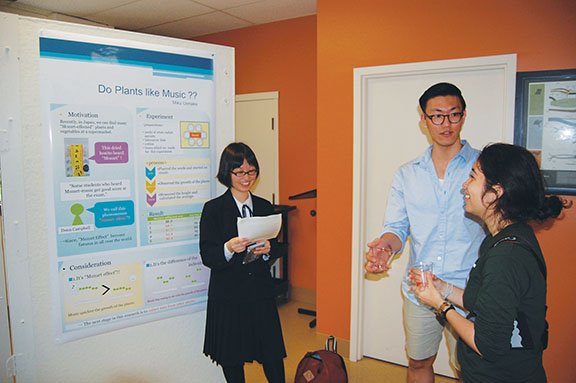HOT SPRINGS — Miku Uenaka bravely stood before four of her classmates and about 25 Arkansas students at the Arkansas School of Mathematics, Sciences and the Arts in Hot Springs on Tuesday afternoon before a poster describing how music might help plants grow.
The Japanese 11th-grader not only had to explain what is called the Mozart effect (the idea that plants will grow taller and faster if the music of the 18th-century composer Wolfgang Amadeus Mozart is played for the plants for hours at a time), but Uenaka had to give her talk in English.
Having already apologized that her English was not as good as she would like it to be, she told the gathering of students, teachers and guests about how she measured the growth of white radishes grown from seeds under laboratory conditions with equal sunlight, water and care. She found that in four out of five experiments, the plants that “listened” to the music grew taller than those cultivated in quiet.
Her conclusion, she said, was that her results beat the law of averages, but that much more study is needed, using other plants, before anything close to proof can be established.
The talk was met with applause, as much for her efforts in English as for her research results.
Uenaka was one of five students from Tennoji High School in Osaka, Japan, who visited with ASMSA students Tuesday and Wednesday. All the Tennoji students gave presentations on their research in English after three students from the school in Hot Springs spoke about their research projects.
“English is very important for these students,” said Fumi Asada, an English teacher at Tennoji who served as an interpreter. “With English, you can communicate in so many different countries, and it is the language of sciences today.”
Seth Gilchrist was one of the presenters from ASMSA. He talked about a six-month project to check on temperature changes and possible pollution of the spring water in the Hale Bathhouse. The student got permission to check the spring water that comes up in the basement of the Hale on Bathhouse Row. He took samples and checked for changes in the dissolved solids and the silica or sand suspended in the hot spring water.
Gilchrist, in cooperation with the National Parks Service, took samples from August though January and found only slight changes that corresponded with rainstorms during the recent dry winter. The water remained well within safe limits throughout the time of testing, Gilchrist said.
“It was a unique moment for students to make contact and become colleagues and mutual friends,” said Toshyuki Morinaka, a teacher and administrator for Tennoji High School, using Asada as an interpreter.
Morinaka said the story of how the Japanese students came to Hot Springs to meet the ASMSA students, tour Hot Springs and see firsthand the interesting assortment of minerals to be found in Arkansas started five years ago.
A Japanese television show about interesting geological places around the world ran a program about crystal mining in Garland County and mentioned the variety of minerals that can be found in the area. A travel executive mentioned the show to a group of geologists, who then talked to Morinaka about bringing students to Hot Springs. Morinaka said he was also interested in seeing the area.
He and two other teachers came to the Hot Springs area in 2010. During the trip, he found out about ASMSA.
Tennoji High School is attached to Osaka Kyoiku University, just as ASMSA is a division of the University of Arkansas System. In addition, Tennoji has been designated as a Super Science School, a designation awarded by the Japanese government for schools that specialize in the teaching of science, technology and mathematics, much as the Arkansas School for Mathematics, Sciences and the Arts provides advanced classes for junior and senior high school students from around the state who are looking for more-challenging studies.
In past years, more than 20 students from Tennoji would visit ASMSA and Hot Springs, but this year, the school trip was not funded by the Japanese Super Science program.
“The number of students who could afford to pay their own way to come was smaller this year,” Asada said. “The trip is a remarkable aid to the academic and social development of the students. Many of our students strive to study abroad, especially in America.”
The science high school in Osaka also sends students to Thailand annually to meet students at that country’s math and science high school, Asada said.
On Tuesday afternoon, the students from Osaka, along with host students from ASMSA, toured downtown Hot Springs, visiting Bathhouse Row and other sights in the city and Hot Springs National Park.
After dinner together that night at the ASMSA cafeteria, students from Osaka gave a presentation about their school for ASMSA students and talked about Japanese culture.
The visiting students spent the night in the dormitories at ASMSA with their hosts.
On Wednesday, the students from Japan and their host students made their annual visit to the Wegner Quartz Crystal Mines near Mount Ida — the mines featured in the Japanese television program that led to the students’ visit to Hot Springs. They spent the morning digging for minerals.
Darbe Gallardo, one of the ASMSA student hosts, was paired with Nana Kadota, a student from Tennoji.
“It was fun to interact with her and try some foods she was not familiar with,” Gallardo said. “I tried talking with Nana with my minimal Japanese. I thought it would be scary for both of us, but we ended up laughing half the time.”
Gallardo was one of the Hot Springs students selected to travel to Hanamaki, Japan, under the Hot Springs Sister City Program in July last year.
Staff writer Wayne Bryan can be reached at (501) 244-4460 or wbryan@arkansasonline.com.
